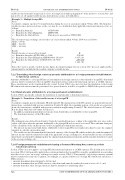Page 552 - SAIT Compendium 2016 Volume2
P. 552
IN 63 (2) Income Tax acT: InTeRPReTaTIon noTes IN 63 (2) taxable income from any foreign trade is a loss, it is ring-fenced under paragraph (b) of the proviso to section 20(1) and
may not be set off against taxable income derived from a source in SouthAfrica.
Example 8 – Multiple foreign PEs
Facts:
A resident company operated 3 foreign branches during the year of assessment ended 30 June 2014. The branches’ taxable incomes and assessed loss, as the case may be, as calculated in their applicable functional currencies were as follows:
(a) Branch in Australia
(b) Branch in the United Kingdom
(c) Branch in the United States
The relevant average exchange rates for the year of assessment ended 30 June 2014 were as follows: AUD – 9,5380
GBP – 16,9203
USD – 10,3904
Result:
Taxable income or assessed loss in rand:
(a) Branch in Australia (AUD50 000 × 9,5380)
(b) Branch in the United Kingdom (GBP60 000 × 16,9203) (c) Branch in the United States (USD20 000 × 10,3904) Total
R 476 900
1 015 218 (207 808)
1 284 310
AUD50 000.
GBP60 000.
Current year assessed loss USD20 000.
Since the total is a positive taxable income gure, the ring-fencing proviso in section 20(1) does not apply and the amount must be included in the resident company’s taxable income.
7.2.2 Translating other foreign currency amounts attributable to a foreign permanent establishment to functional currency
Amounts attributable to a foreign PE that are denominated in foreign currencies other than the foreign PE’s functional currency must be translated to the foreign PE’s functional currency unless the functional currency is a CMA currency. These amounts may not be translated directly to rand. Section 25D(2) does not state how the translation to the foreign PE’s functional currency must be performed. As a practical matter, it will be acceptable to SARS if the spot rate is used.
7.2.3 Rand amounts attributable to a foreign permanent establishment
Section 25D(2) speci cally excludes the translation of rand amounts to functional currency.
Example 9 – Translation of the taxable income of a foreign PE
Facts:
A resident company operates through a PE in Country R. The main portion of the PE’s pro ts are generated from sale transactions concluded with persons resident in Country R while the remaining portion of its pro ts are generated from sale transactions concluded with persons resident in neighbouring Country S. The of cial currency of Country R is the dinar while that of Country S is the peso.
In addition, rand-denominated interest income from South Africa is attributable to the foreign PE. The functional currency of the PE is dinar.
Result:
The trading income derived from Country S must be translated from peso to dinar at the applicable spot rates on the earlier of the dates when the amounts attributable to the foreign PE were received or accrued. These amounts form part of the calculation of the taxable income of the foreign PE in its functional currency.
The interest income from South Africa attributable to the foreign PE is not translated to dinar because the original amounts are already expressed in rand.
The taxable income determined in the functional currency of the foreign PE (which excludes the rand-denominated interest income) must be translated to rand at the applicable average exchange rate. A nal taxable income calculation must then be performed by adding together the original rand-denominated amounts and the amounts translated to rand at the average exchange rate.
7.2.4 Foreign permanent establishments having a Common Monetary Area currency as their functional currency
Section 25D(2) does not apply to a foreign PE if its functional currency is a CMA currency. The default spot rate rules in section 25D(1) will generally apply in these situations [unless the foreign PE is owned by an individual or non-trading trust that elects to use an average exchange rate under section 25D(2)]. Consequently, each foreign currency amount must be translated to rand on recognition. Accordingly, as a practical matter, if a foreign PE’s functional currency is a CMA currency –
• amounts denominated in rand must be left in rand;
• amounts denominated in any CMA currency (other than rand) must be translated to rand at a rate of 1:1; and • amounts derived in other foreign currencies must be translated to rand using either –
544 saIT comPendIum oF Tax LegIsLaTIon VoLume 2


